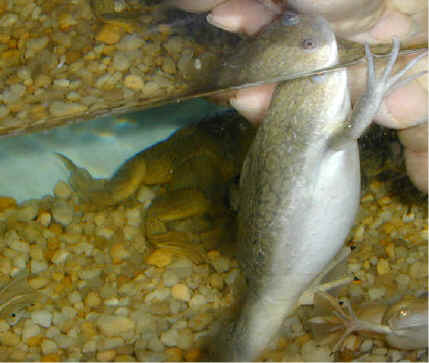|
How To Tell Males From Females
Males
- usually 20% smaller then females
- slim bodies and legs
- no cloaca (flat butt)
- black nuptuial pads on forearms at sexual maturity
- sings or calls out for a female (sounds metalic, or as i say, a cricket chirping underwater)
Females
- large, plump, pear shaped with chubby legs
- small bump between the legs, this is the cloaca where eggs and waste are passed.
- lack nuptuial pads, but can have dark or smoky palms of their hands. (I call this "dirty hands")
- They do not sing or call out like males do, but they do answer back which is extremely unique to the animal world. (Most
females of any species rarely answer back.) The female frog makes a soft rapping call for acceptance or a slow ticking call
for rejection.
Breeding African Clawed Frogs
When a male is ready to breed he will begin calling out for a female. She will answer him back by clicking softly. He
will grasp her from behind holding her right above her thighs. He then will squeeze her until she begins to lay eggs, and
fertlization takes place outside the body. Females can lay hundreds of eggs at one time and they will stick to everything
all over the tank. If not removed shortly they will eat them.
The condition of the tank is crucial for successful breeding. They don't like it too hot or too cold, room tempurature
is perfect. A good way to "set the mood" is to do a 30% water change and refilling the tank with cool water. This will fake
the male frog into thinking it is "spring rain" and he will being to call for a female. The quiter and darker the tank is
the easier it is for them to breed. I suggest doing a water change with cool water in the evening and then shutting off the
filters and lights. The darkness and the quiet will make them feel comftorable and secure.
Females should only be bred once every 3 months (4 times a year). It is possible to over breed frogs to the point of
death. You may need to seperate frogs that keep trying to breed. No female should be bred before a year and a half in age
to ensure quality eggs and maturity.
| Plump female full of eggs |

|
| copyright Aqualand Petsplus LA PIC |
| 6 month old male and 5 year old female X. laevis |

|
| Tiwi and Molly Amplexing |
| Xenopus Laevis Amplexing |

|
| Blyn and Nadi |
Selecting a Breeding Pair
In the event you wish to have planned mating of frogs do consider the following. Frogs purchased from the same petstore,
from the same tank, are most likely related. Breeding these frogs together creates a small gene pool and results in high death
rate among tadpoles, deformities in tadpoles and froglests (such as twisted spines), death in froglets shortly after metamorphasis,
a weakened ammune system, and a shortned life span due to a weak ammue system.
THINK AHEAD! What do you plan on doing with all the froglets you raise? This could be hundreds of frogs you
are responsible for. Check with local petstores ahead of time to make sure they are willing to take in the froglets, either
for free, for a small fee or in exchange for store credit.
|

